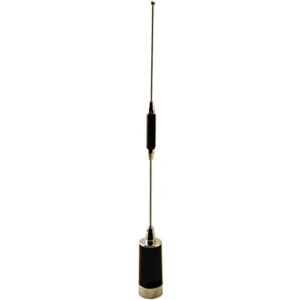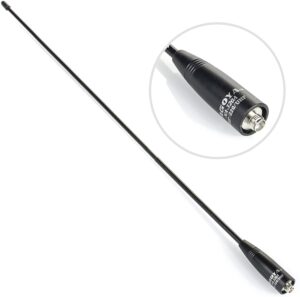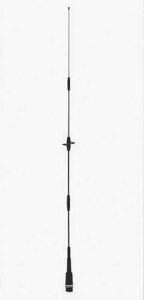What is the best antenna for Yaesu FTM-400XDR? Well, we know the right answer and will help you make an informed buying decision.

The stock antenna supplied with the Yaesu FTM-400XDR is a rubberized ducky like most OEM antennas that don’t perform as effectively as the aftermarket whip-style antennas.
Though built-in antennas of HT radios tend to be handy and flexible for the handheld operation, they’re much less performance-driven and durable than the aftermarket base-loaded whip antennas.
More often, opting for a replacement enables you to communicate better, boosting your mobile unit’s signal reception capability. So without further ado, let’s take a look at our list of the top 4 antennas you can pair with the FTM-400XDR.
The 4 Best Antennas for FTM-400XDR
| Image | Model | Price |
|---|---|---|
 | Tram 1180 (Top Pick) | Check Price |
 | Nagoya NA-320A | Check Price |
 | Comet SBB-7NMO | Check Price |
 | Comet CA-2X4SRB | Check Price |
Tram 1180 (Editor’s Choice)
Arguably one of the most performance-driven dual-band NMO antennas out there, the Tram 1180 comes reinforced with premium components for ensuring long-term performance. Different categories of broadcasters, radio operators, and amateur radio enthusiasts can take optimum advantage of the 1180 pre-tuned 144MHz-148M Hz VHF/430-450MHz UHF antenna for crystal-clear two-way communication.
Every 1180 dual-band NMO antenna piece has been painstakingly designed and manufactured with scrupulous care to guarantee high-quality transmission for across-the-board applications.
This pre-tuned and configured Tram VHF/UHF amateur antenna is guaranteed to stay in effective service for many years on end. The Tram 1180 dual-band NMO amateur antenna has been designed especially for ham or amateur radio enthusiasts who live in small apartments or condos in densely populated regions. In such regions, you cannot mount or erect structures on the roof or ceiling of your tenement owing to municipal constraints and restrictions.
So you’ve limited options for pressing into service your ham radio or VHF/UHF radio. And this is precisely where the Tram 1180 comes to your aid thanks to its modest dual-band antenna, which provides an astonishing transmission power and receptivity range. And since this Tram antenna has been pre-tuned, beginners and first-time operators will find it easy to exploit its features.
The Tram 1180 comes pre-tuned for 144MHz-148MHz VHF and 430MHz-450MHz frequencies-the ideal frequency ranges for amateur radio use. In addition, the antenna offers excellent gains of 2.4dBi and 4.5dBi on VHF and UHF, respectively, which means you won’t experience any reception issues in mountainous or rugged terrains. Crafted out of high-quality steel, the antenna is extraordinarily rust-resistant and endures inclement weather with incredible effectiveness.
Pros
- Highly robust and resilient: Black base with a stainless steel whip
- Resists corrosion
- Base loaded dual-band high-gain antenna
- 2M/70cm 5/8 wave antenna with a whip length of 36.5 inches
- Outstanding SWR for VHF and UHF
- It comes with a powerful magnetic base for facilitating stable mount on metal
Cons
- Band edges are somewhat steep and narrow for effective SWR
Nagoya NA-320A
A brand new, state-of-the-art antenna from Nagoya, the NA-320A is modeled on the retractable NA-771 with support for 1.25m or 220MHz band VHF radio spectrum exclusively for amateur radio use. However, the Nagoya NA-320A also supports a broader transmission/reception range (RX: 118̴ 960MHz). Like all other Nagoya antennas, every NA-320A is stringently tested, meticulously tuned, and configured for the prescribed frequency range it was designed to begin with.
The NA-320A is a highly sought-after antenna held in high regard by ham radio operators, truckers, search and rescue teams, highway patrolmen, and so on. This is a high-gain HT antenna equipped with a built-in flexible whip that helps boost the performance of your wideband handheld scanner. One quality of NA-302 that you’ll definitely like is that the transmitter is compatible with all three bands, viz. 0.7m, 1.25m, and 2m.
In other words, you can use the NA-320A to catch all radio stations lying in the 136-174MHz, 220-225MH, and 400-520MHz. More often than not, you’ll be pleasantly amazed when the antenna intercepts stations that you had never heard of or knew that they existed. Moreover, with a power output of up to 20W and capable of producing an incredible gain of +2.15dBi, this Nagoya antenna’s signal reception quality is exceptional.
The NA-320A has been made from the best grade of material as the aerial feels chunky when you hold it. On the other hand, the antenna’s height (17.7 inches when fully extended) is ideal for boosting faint frequencies. In addition, the antenna features an SMA female connector rendering the receiver companionable with any UHF/VHF radio having a male-type plug.
You can make the most of the Nagoya NA-320A, primarily if you’re based in an area with a high noise level and high population density.
Pros
- It fits on all models of BaoFeng, specific BTECH models, many Kenwood and Yaesu models, and all other models that accept SMA-female connectors
- Works perfectly with Tri-band -144, 220, and 440 frequency ranges
- Elongated whips help improve signal
- Extremely high-gain of 2.51dBi for promoting excellent signal reception
- RoHS compliant
Cons
- SMA adapter is a bit flimsy
- The storing magnet could’ve been a little stronger
Comet SBB-7NMO
The SBB-7NMO dual-band antenna by Comet is a 144-148MHZ VHF/440-450MHz UHF mobile antenna with vertical gains of 4.5dBi (VHF) and 7.2dBi (UHF). The SBB-7NMO features a toughened black base with a 55” long fold-over aerial capable of handling up to 70-watts of power which boosts signal reception. This dual-band mobile antenna from Comet is compatible with an NMO connector mount.
Unlike most Comet mobile antennas having a receiver more than 29” in length and featuring an integrated fold-over pivot in the base, the SBB-7NMO has a manual hinge. In other words, you’ll have to pull the hinge out of the socket and lower the SBB-7NMO’s whip sufficiently to enter parking lots or garages. Comet technicians redesigned and upgraded the feeble spring inside the fold-over, and now the SBB-7NMO antenna sports a threaded neck around the pivot.
So all you’ve to do for exposing the hinge is slacken up the collar and lift it, and the antenna remains erect and ramrod straight. So, all in all, the Comet SBB-7NMO is a top-quality and pocket-friendly HT antenna allowing you to communicate with effectiveness and ease.
Pros
- Dual-band (VHF/UHF/2m/70cm) mobile HT antenna
- 55” long whip
- NMO connector
Cons
- Susceptible to slight slackening up after using for a long time
- You’ll not be able to use the antenna when it’s lying down, and you’ll have to adjust the angle for keeping it straight
Comet CA-2X4SRB
The Comet CA-2X4SRB comes across as a top-quality broadband VHF/UHF mobile antenna created especially for FRS frequency ranges and communicating via land mobile and ham radio. In addition, the CA-2X4SRB antenna allows amateur radio operators to team up with community search and rescue operations and other public service providers, thanks to the antenna’s TX and TR capability in VHF and UHF bands.
The CA-2x4SR furnishes a fantastic gain and extensive coverage, making this antenna ideal for VHF and UHF voice communications. The antenna has been made of durable materials that keep it functional for years and has a black anodized finish to prevent corrosion. While designing this broadband antenna, Comet kept in mind that the transmitter served the communication needs of both land mobile users and amateur broadcasters.
As a true-blood broadband antenna, the CA-2x4SR performs well beyond your expectations. Many pro and amateur (ham) radio operators have reported that this antenna is an excellent listener. For instance, many radio operators have testified that they could hear conversation lines from more than 80 miles away with a mag-mount.
Pros
- 2m/70cm dual-band antenna
- Max power: 150W
- Antenna length: 40”
Cons
- Vulnerable to snapping if it strikes an object or brushes against tree branches, and once it breaks, its irreparable
What You Should Know About Yaesu FTM-400XDR
The Yaesu FTM-400XDR was the introductory mobile unit launched especially designed and engineered to be a suitable radio associate for using on Yaesu’s ‘System Dual-Mode System.’
The C4FM FDMA, in sharp contrast to other digital modulation systems within FDMA, offers an exceptional quality of communication. It is worth mentioning that C4FM comes across as the standard commercial communication mode for FDMA gadgets and is thus poised to be the powerful digital method of communication in the coming years.
The FTM-400DXR can operate in ‘1’ analog mode and three (3) digital modes for catering to a wide variety of professional and amateur operators. Packed to the hilt with features, the FTM-400DR is Yaesu’s first digital mobile unit with a built-in AMS (Automatic Mode Select) function. The AMS functionality helps in sensing the received signal mode at once.
FTM-400DXR allows smooth operation and does away with the hassle of manually swapping out modes of communication thanks to AMS. The following are some of the most practical features of the FTM-400XDR:-
- Stunning display
- Analog and Digital FM capability
- Extra-wide frequency range
So, The Best Antenna for Yaesu FTM-400XD Is…
All the HT antenna models listed above are perfectly compatible with any standard ham radio or walkie-talkie. While the Nagoya tri-band model offers extended coverage, the other models have much longer whips, offering an improved radiating range.
However, the Comet models enjoy a clear edge because of their extra-long antennas, high output power, and high gain.